#an inhabitant of carcosa
Note
Me while reading it "I need to read King In Yellow! I want to see scenes of this illustrated!"
Me now: "I need to read more fic about Jonathan and Mina's love 🙃🙃🙃 Just that or while they're fighting more bad guys and monsters"
But I still want the first part too lol
The King in Yellow short stories can be read here
Ambrose Bierce's (earlier!) short story, "An Inhabitant of Carcosa," can be read here
Aaand my personal favorite short story of Algernon Blackwood's, from which [SPOILER CHARACTER] takes a jab at [LOVECRAFTIAN SPOILER CHARACTER] for being unoriginal in his secret machinations and inflicting otherworldly Knowledge That Seeds Madness, is "The Man Who Found Out," available here*
*(Pour one out for Professor Mark Ebor, my most beloved and underrated nice old man blorbo)
As to Jonathan and Mina being loving and lovingly kicking evil's ass, you will just have to wait for @mayhemchicken-artblog's comic c:
#and now my own sinister plot is unveiled#all these fanfics have secretly been meticulously orchestrated bait#to trick people into wanting to read even MORE classic supernatural lit#I am a bookworm and scribbler and I shall use my powers for evil#my writing#the league of extraordinary gentlefolk#the king in yellow#robert w. chambers#an inhabitant of carcosa#ambrose bierce#algernon blackwood#the man who found out#jonathan harker#mina harker#dracula
63 notes
·
View notes
Text
“Over all the dismal landscape a canopy of low, lead-coloured clouds hung like a visible curse. In all this there was a menace and a portent—a hint of evil, an intimation of doom. Bird, beast, or insect there was none. The wind sighed in the bare branches of the dead trees and the grey grass bent to whisper its dread secret to the earth; but no other sound nor motion broke the awful repose of that dismal place.”
Ambrose Bierce, An Inhabitant of Carcosa.
8 notes
·
View notes
Text
Revelation of Hali
For there be diverse sorts of death -
Some wherein the body remaineth;
And in some it vanisheth quite away with the spirit.
This commonly occurreth only in solitude
(Such is God’s will)
And, none seeing the end, we say
The man is lost, or gone on a long journey -
Which indeed he hath; but sometimes
It hath happened in sight of many,
As abundant testimony showeth.
In one kind of death the spirit also dieth,
And this it hath been known to do
while yet the body was in vigor for many years.
Sometimes, as is veritably attested,
It dieth with the body,
But after a season is raised up again
In that place where the body did decay.
1 note
·
View note
Text
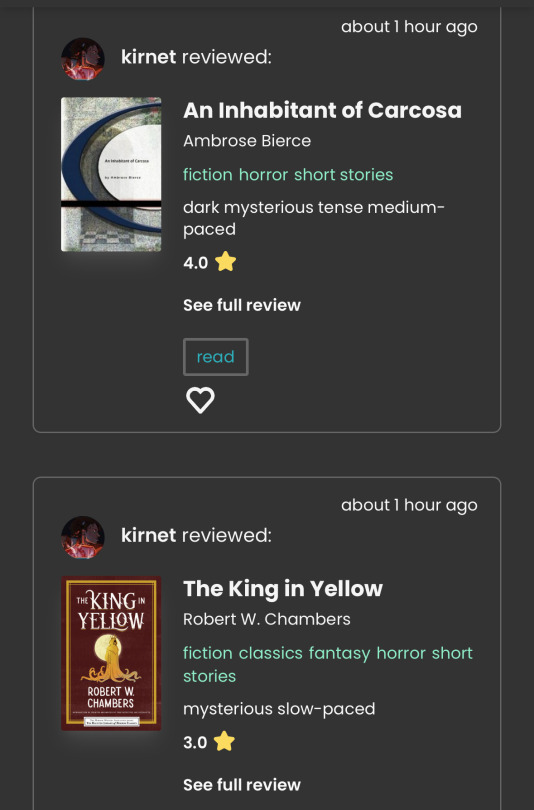
Something happened here
#I should make a TD inspirations reading challenge ooooohhhh#an inhabitant of carcosa is not but it was a minor inspiration for chambers and I really like it so I’m counting it#ramblings
8 notes
·
View notes
Text
picked up a copy of we’ve had a hundred years of psychotherapy and the worlds getting worse by james hillman im veryyy excited to read it
1 note
·
View note
Text
Carcosa? The monstrous city at which unspeakable horrors are done in name of the great old one Hastur they call their leader? Great. How much is the average rent price?
The king of Carcosa will eventually consume and destroy the entire city with everyone in it when the time comes to increase his power? Well that's every politician ever for you, tell me something new.
The entire city is populated by a cult that worships the King and they often do unspeakable horrors in his name? Yes im aware with how political parties work
The nearby lake of Hali is said to be inhabited by a being of unspeakable power which sometimes comes into conflict with the spawn of Cthulhu at that lake? YOU'RE TELLING ME THIS PLACE EVEN HAS A NICE LAKE TO SIT NEXT TO!? And yes I am also aware about how tourists can be annoying sometimes.
Your spooky "Black stars on a bright sky" you keep mentioning imply there is little air pollution, since seeing a large amount of stars in a city is often wishful thinking. Housing crisis considered this place doesn't seem half bad

#hastur#the king in yellow#the feaster#lovecraft#lovecraftian horror#funny#literature#books#book#feaster#carcosa#Cthulhu#cthulhu mythos#cosmic horror
855 notes
·
View notes
Text

there was one persons interpretation of what this visualization is and it hit me so hard i think about it a lot
spoilers under the cut. ill be brief (if i can help it) and keep it pretty cut and dry without much flowery imagery (if i can help it) but whoever reads it can take the pieces and put them together and fill the gaps in with humanity
the various paintings of "isle of the dead" flash through elster
ALSO though the isle of life. (important)
a word that is IN the game is "carcosa" but the word is redacted in every mention of it. users only found it due to datamining.
"carcosa" is a term used in the "king in yellow", and a short story "an inhabitant of carcosa" which was inspired by a poem called "carcassonne". in the short story, there is an ancient, abandoned and ruined city called carcosa and the person wandering it is dead who used to live there. they forgot they were dead and forgot what the city was. until they see their own tombstone and then they remember. the story brings out themes of unfamiliarity, longing, contemplations of death, home
there was a promise made. (did elster make a promise? was it a promise they made to each other? either way.) elster at this moment remembers the promise.
the isle of the dead can very easily be interpreted to be "carcosa". a longing for death, to move on. to be at peace.
elster is bringing that to ariane. bringing her carcosa, her promise. there are several moments that present elster as the ferryman who carries souls from life to death. elster is bringing death to ariane (as was their promise?)
but there can be more to it than that. elster herself, is arianes carcosa. someone dear to her, someone special and someone who is home for her. elster is making her way back to ariane so they can be together (as was their promise?) remember, the isle of life painting ALSO flashes in elster,
maybe their promise was that they would never leave eachothers side. or that they would die together, or that ariane wouldnt suffer. or maybe that neither would suffer. maybe it was a promise to take care of eachother and be there to finish things for the other when time came. or that no matter how bad things got, theyd be with eachother.
but i absolutely LOVE the dynamic as framing elster as the harbinger of death for ariane but also as a harbinger of peace and comfort for ariane. she wants to die, but. she wants elster too. if she could live in peace and comfort with elster. i dont think shed want to die. but she cannot live in peace or comfort. in every sense, elster is her carcosa, and in that moment, elster remembers.
96 notes
·
View notes
Text
I have really enjoyed Signalis from a viewpoint of considering its origins and its makers. It is very clearly East Germany in Space. Well, East Germany in Space with a smattering of Chinese and other Asian influences.
The tech is very Soviet retro-futurism. The architecture of their society, from what we get to see, felt very Eastern Bloc brutalist. That's even without addressing the fact the flag is just the East German flag with some changes to it.

The makers of the game are very much German, and know their history, know their references. One of the planets is even named after a leftist paramilitary organisation from the Weimar Republic days.
Aside from the blatant The King in Yellow references (you literally pick it up to get to the game beginning in earnest) I can sense some relation to An Inhabitant of Carcosa. The painting that keeps showing up is the real life Isle of the Dead painting. I'm sure there's others, I just don't know them.
It's been fascinating to consider it from an outside perspective considering what exactly the creators were looking at for inspiration, or decided to reference in the creation of the game.
I am probably not finishing the game for its subject matter is hitting too close to home - but it's definitely a thought provoking game, and I have liked the aesthetics. (I especially like the Penrose's design)
67 notes
·
View notes
Text



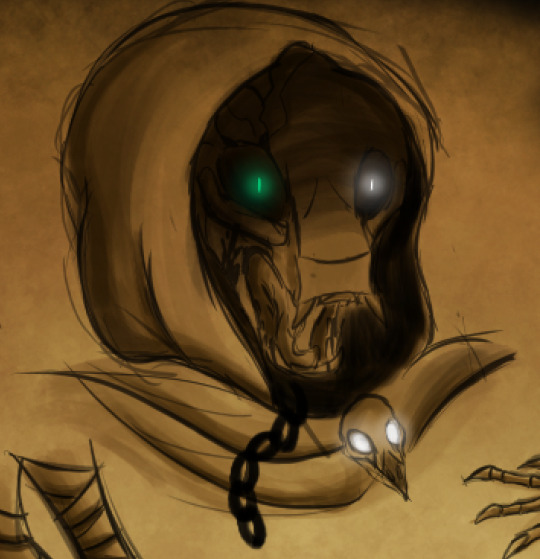
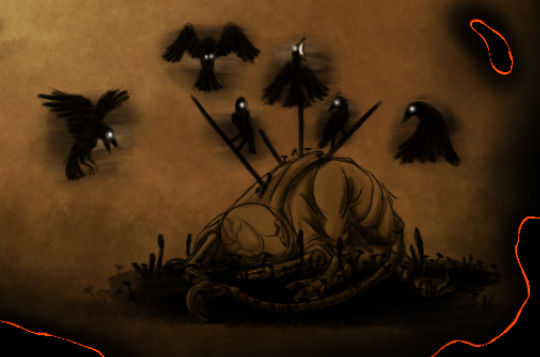
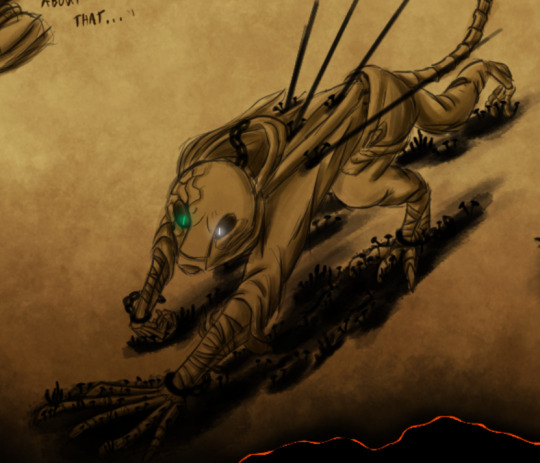
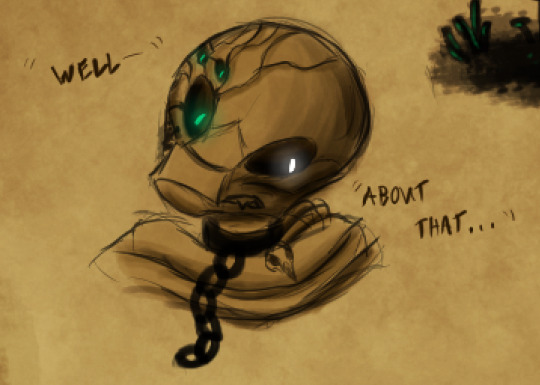
Eldritch/Cosmic Horror AU: Ink Inkwell
"The most merciful thing in the world, is the inability of the human mind to correlate all its contents. We live on a placid island of ignorance in the midst of black seas of infinity, and it was not meant that we should voyage far." - H.P. Lovecraft
Inkwell, originally Ink, was taken from his modern home by an eldritch beast known as ABERRATION, who turned the shy skeleton into a creature of rot and decay so he could have the strength to save its lost twin, ARCHANGEL. Although its intentions were of goodwill, the following downward spiral shows how much a simple dose of the wrong type of power can ruin a person.
"The Fragments of Reality" is a story of redemption first and foremost, the overall theme is one of atonement and finding oneself beneath a dark smog of gruesome actions.
(Outline is 98% complete, fic continuation soon)
Eldritch Creatures
ABERRATION: Eldritch "Nightmare"
ARCHANGEL: Eldritch "Dream" (deceased)
THE NEON GOD: World parasite
TAZOULOTH: Watcher
CAINSUBYTHAL: Soul Hound
THE KING IN YELLOW: Bearer of madness and damnation, the possessor of the eight eldritch terrors
ALDARNOTH: Tunneler between worlds
TYTO: The night
YOG ELARBASTOTH: Bearer of death and finality
YOG RYNORATH: Bearer of primordial existence and apparition
CARNHOLT: Alchemist
DAGON: Lark of decay and rot
CARCOSA: Harbinger of fatality
(Place your bets on who cursed Inkwell)
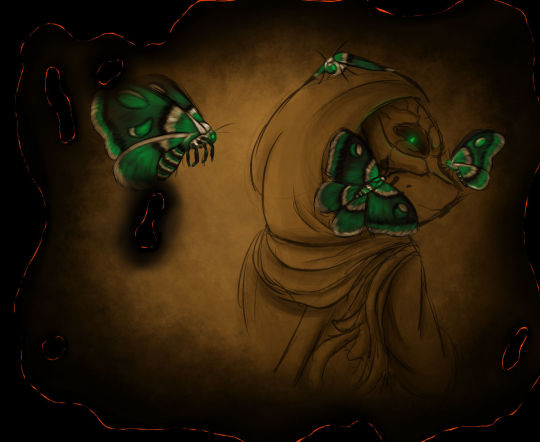
Inkwell
"I know always that I am an outsider; a stranger in this century and amount those who are still men." - H.P. Lovecraft
Inkwell himself goes through multiple character evolutions throughout his story. The references shown here are at the peak of his arc, showcasing his uncontrollable rot, creature companions, and the full effects of the curse.
Though being a multiverse hopper, he becomes unable to use all he's seen as warning for others, and instead a telling of the future. When common inhabitants approach him, all Inkwell can see is the dead and rotting face of what awaits the unfortunate soul.
There is no light at the end of his mission, no joy at the obtainment of ABERRATION's goal, only the nothingness of the infinite dark, and the creatures that lie beyond and between.
-
"I spent too long hearkening to the whispers that brushed against my skull, carving their call of purpose and fulfillment. Becking with black tendrils and seafoam eyes. I heed the call like some desperate dog with its leash loose and its tail broken.
Even now I still chase those whispers and phantoms, as useless as it may be. I have chased for so long that I have become one of them, a ghost, a creature of foreign realm, a bad omen to not be spoken of.
Do not be the dog Cross, do not chase the murmurs against your skull, do not heed to the blackened tendrils and ceaseless eye. Turn around. Before death and decay follow your every step." - Inkwell
-
(Ask and fanart are welcome)
(Inspired by SCP and H.P. Lovecraft)
(In collab with @sunlit-witch 's 50/50 au (Equiverse). Huge thanks to them, @phinix53 , and @pastelaspirations for letting me brainstorm and hash out ideas.)
67 notes
·
View notes
Note
So you call this place lost Carcosa despite the fact it keeps showing up?
Wellllll the name "Carcosa" first appeared in Ambrose Bierce's An Inhabitant of Carcosa (1886), where it had already been destroyed, but it wasn't described specifically as "Lost Carcosa" until Robert W. Chambers' The King in Yellow (1895) - specifically Cassilda's Song, which is the prelude to The Repairer of Reputations
Bierce's work was also the first mention of Hastur - in Haïta the Shepherd - but he's a very different entity and hasn't yet been linked to the figure The King In Yellow, as well as Hali, which Chambers later borrowed for Lake Hali.
HP Lovecraft later borrowed from both authors, but I if I'm remembering right it was August Derleth who truly linked Hastur and The King in Yellow, and made Hastur into a specific monster in Lake Hali and the Lord of Interstellar Spaces.
Derleth's (derogatory) work (if you can call it that) is what inspired Hastur's entry in the Cthulhu Mythos section of the Advanced Dungeons and Dragons Deities and Demigods book, which doesn't mention the King in Yellow at all.
There was another author who included clockwork into the whole Vibe, but I don't remember if that author was working for/with the Delta Green folks or not, and also I'm not allowed to look it up until we finish our playthrough of Impossible Landscapes.
@darkersoul is the handler for that one and is, of course, more knowledgeable of the specific history of Hastur than me.
16 notes
·
View notes
Text
King in Yellow Reading List
This is just the basic origins of the core King in Yellow lore as far as i could find, and i’m sure i missed some things. The main thing i couldnt find is a single origin point for the idea of the kiy as an aspect/avatar of the more powerful god hastur, or even just those two as alternate names of one entity. The closest i found for that was actually the Call of Cthulhu ttrpg, which may very well be the source tbh. In terms of Classic Cosmic Horror i could find copies of online though, i think this covers it.
The King in Yellow Robert W. Chambers
Collection of short stories, the first four of which feature the apocryphal ‘King in Yellow’ play, and are introduced with excerpts from it.
An Inhabitant of Carcosa Ambrose Bierce
Short story, origin of the city of Carcosa and Lake Hali, both used by Chambers in the King in Yellow play.
Haita the Shepherd Ambrose Bierce
Short story, origin of the name ‘Hastur’ here used as a god but borrowed by Chambers as a city name.
The Whisperer in Darkness HPL
Novellette, more explicitly links Hastur with the yellow sign, and thus the King in Yellow. Also brings the KIY/Hastur into the cthulhu mythos in general.
The Return of Hastur August Derleth
Short story, reintroduced ‘Hastur’ as a god rather than a city.
More Light James Blish
Short Story, Reconstruction of the King in Yellow play inside a narrative framing device.
Apart from the stories listed here, The Hastur Cycle edited by Robert M Price is a great collection that includes most of these as well as context and introductions for each story so thats a great resource, i just couldnt find a link that wasnt a pdf download.
Additionally, its not made explicit and its just one small scene so i didnt include it in the main list but I think the King in Yellow appears in the Dreamquest of Unknown Kadath, and in terms of lore for Malevolent fans the dreamlands are definitely relevent and a lot of what happens in that book in general is paralleled in season 2 which is fun.
#malevolent#the king in yellow#a#obligatory note that none of these r recs based on quality or like. endorsement of the writer. most of these dudes suck#this is just for Context#honestly just finding a copy of the hastur cycle is probly ur best bet tho#it is online i just know better than sharing pirating links#edit: i put in a readmore bc it was too long even on desktop
60 notes
·
View notes
Text
Books I Read in 2024 #4: The King In Yellow (Robert W. Chambers, Warbler Classics (originally F. Tennyson Neely), 1895)

The King In Yellow is a series of nine short stories and poems, linked primarily by the narrative device of The King In Yellow, a play and general text in the world of the story that is associated with madness and the forbidden.
It's fun to return to older modes of writing from time to time, especially the established classics. I've known about The King In Yellow for a fairly long time at this point as a touchstone of cosmic horror and an influence on H.P. Lovecraft, along with about a billion other people working in the horror space since the 1890s. My personal first experience with stories influenced by it is SCP-701, The Hanged King's Tragedy, which is an SCP object that manifests in the form of a Carolinean era English play that is associated with madness, suicide of its participants and the manifestation of a mysterious figure at productions of said play. It's a pretty direct reference point, but I did fall in love with the idea of a play founded on madness.
You see it referenced all over the place; Hastur (sometimes a place, sometimes a person), lost Carcosa, the Hyades, though these are actually borrowed from the stories An Inhabitant of Carcosa and Haita the Shepherd by Ambrose Bierce (but not linked directly, as the only thematic link is that the Carcosa of Bierce is that the city is a long-lost and destroyed city of antiquity), or most prominently after the King In Yellow's publishing, the Yellow Sign.
The fascinating thing to me is how broad the stories of The King in Yellow are. There are nine stories in The King In Yellow, but only 5 (or perhaps 6, if you consider the 6th story, The Street of the Four Winds, to be supernatural; it's mostly just eerie and affecting, to me) of them have clear or obvious influence of the supernatural. The final three stories of the book are simple romance narratives set against the backdrop of contemporary or recent (at the time) Paris and the French art industry, something Robert Chambers had long personal experience with as an American studying abroad in Parisian art schools in the years before.
This is the first novel in this list that I've gone back to read historiography about after finishing. Part of that is that there is not a great deal of reporting around modern novelists and their legacies for obvious reasons, but part of it is that this book was truly a baffling read for the final three stories.
I don't say this as a criticism, but it replicated a feeling I get reading some fandom zines of the last few years, especially ones that include fiction. There is sometimes a breakdown that happens in a themed project where one author or artist doesn't seem to be on the same page as the rest of the team on what is supposed to go in the zine, but was nevertheless accepted. It's just funny to read stories like the first couple, stories of madness and loss, and then have a Parisian story of romance in the city of lights amidst a siege or art-school intrigue.
Robert Chambers' work is extremely evocative in its work about place and dress, giving a great deal of attention to mood and scene. His dialogue is very much of it's era, sometimes sharply funny, sometimes eluding me until I've repeated it two or three times to myself to find the cadence of what it was attempting to convey. It's far from unreadable, and even when it dragged the most I kept myself in the game by the strength of his imagery, and it felt surprising to me to see critiques of Robert Chamber's work from his contemporaries.
H.P. Lovecraft was undoubtedly influenced by his work, but also described his work as such:
Chambers is like Rupert Hughes and a few other fallen Titans – equipped with the right brains and education but wholly out of the habit of using them.
It feels a bit mean, but it's definitely not wrong. I think the grandest part of this novel is its legacy and the elision of detail for its major thematic work, allowing a great deal of expansion for the myth over the century since its published debut. The King in Yellow can be many things; it's been the subject of podcasts, stories and movies and television all drawing upon its influence to greater and lesser extents.
7 notes
·
View notes
Text
EXPERIMENT RESULTS:
actually, I just may not be a Dionysian, and that's okay. I think there's a lot of adjacencies (oh thank god, that is a word) -- a hilariously high amount of adjacencies, at that -- which muddled the waters for these past years (to say nothing of Grey's identification with the guy, which got us started on the path in the first place). Dionysos is like the earthly version of Me, but he is very much an earthly entity, and being Not From Here makes things difficult to navigate, I think. (V's [Carcosa remix] version of the prayer was a decent gap-bridge but ironically -- or uh. maybe not ironically? the opposite of ironically? -- that also might be what made me see the gap in the first place)
I think Dionysos was a signpost more than a destination, for me, and the fact that I've lingered here so long has probably hamstrung me a bit. been trying too hard to wriggle myself into the Dionysian box and now my shape is all warped and squozen.
the one thing I think he could have been good for is joyful embodiment -- learning to live in an earthly form with grace instead of resentment -- and I do still need that assistance. gonna have to workshop some other possible sources for that
ok adding in some clarifying edits before I tag OP in case they're interested in failed experiments as well as successful ones:
experimental method: lighting incense, invoking Mood by using this one lotion I have that is both decadently scented and shimmery + spritzing rose toner on my face (self-care seems to be a good centering device, particularly for this kind of entity, I think -- and I find scent is particularly evocative), recitation, a minute of quiet reflection
for the recitation I started out using the original prayer but a mutual lightly remixed it in a way that felt More (for me personally) so I used that towards the end, leading to the above revelation
by "Not From Here" I mean I am a walk-in. Grey was the person inhabiting this body before I got the job
we have about a 8? 9? year history with vibing with the concept of Dionysos and about a 4 year history in actually trying to form a relationship with him
@thegodwhocums
#i *could* have done the whole 7 days but frankly... not sure what further insight that would have possibly brought me#the way i see it it's an arbitrary unit of time anyway -- basically just to create a measurable boundary for the experiment#five is as good as seven for that imo#dendrophilia: a musical#one final tag for the road <3
9 notes
·
View notes
Text



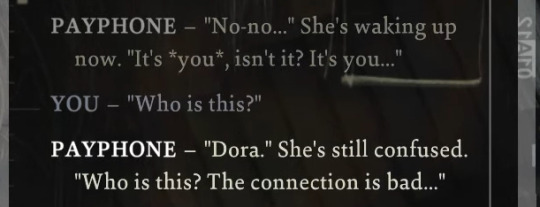

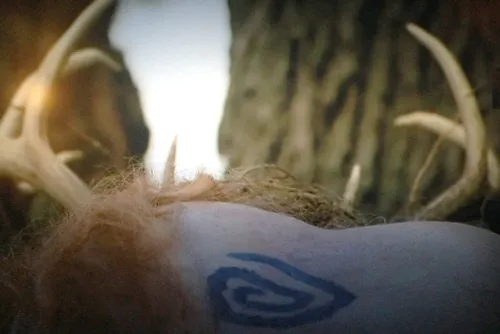



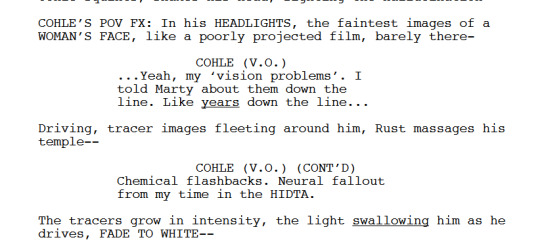

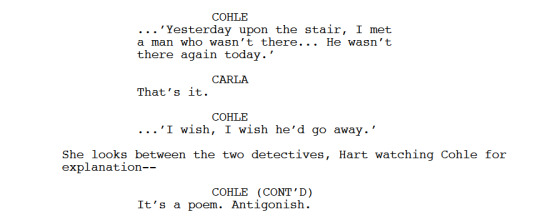




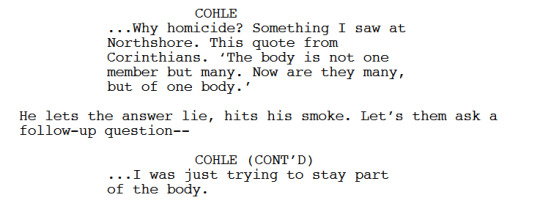


what if Dora Lange haunted Rust Cohle?
True Detective Original Scripts //True Detective (2014) // An Inhabitant of Carcosa, Ambrose Bierce // Disco Elysium (2019) // The King in Yellow, Robert W. Chambers // Excerpts from "Duned", Natalie Diaz // Earthmover, Have a Nice Life // Ptolemaea, Ethel Cain // Medicine, Gustav Klimt (destroyed 1945) // my art
#true detective#does this make sense or is this just entirely localized to my gray matetr#dora lange youre MY hanged man and i have so many thoughts about you#ramblings#web weaving#also i was getting de screenshots and i almost exploded bc i forgot harrys ex is dora... its perfect its HAUNTING THE HAUNTING WORKS#long post
166 notes
·
View notes
Text
Katalepsis after live-read thoughts collection
So, now that im caught up about in time for book 1 to end, i am just regurgitating half-thoughts ive had along the ride, doing some retrospection and working my way through all the stuff i still want to draw.
I think thats one of the big things i really noticed and appreciated about katalepsis. Theres just drawability to it. I havent decided yet if its Hungrys writing style in general, the genre, or most likely, a characteristic of Heathers that got me to figure out i can use my laptop as a drawing tablet. Heather in her internal monologue just has a real appreciation for spaces.
A space is rarely a backdrop to do a scene in, the places and buildings and dimensions are characters to heather in a way that just makest a lot of sense for someone who grew up seeing the personified spirits of the everyday world as well as the varied wilds of Outside.
When the Stairwell trap is sprung, theres a very real feeling of betrayal, the willow house has forsaken raine and heather, who previously thought it a sanctuary.
We later learn that the space was bound, artificial, forced to act against its inhabitants in a way a house usually would not, which fits some themes that come up waaaaayy later.
I originally thought this would just be a quirk of heathers, some flavor to her thought processes, but it really did get picked up as an actual story beat, not just an aesthetic, with the soul of edward lilburnes house.
The Outside places are a bit more metaphorical about this, but strangely more clearly alive as well. The Library is an extension of the catalogue, wonderland is dominated by the eye. Ooran Juhs Projected space is his own physical gullet. Carcosa is the stage of a living play. The very first outside space we get to properly see is on the back of some giant creature, hairs and all.
Theres just Personality to every place that keeps them all so very, very vivid.
Ive been planning to draw wonderland ever since the mirror incident at the very beginning of the story, and in a very funny way, as ive drawn other stuff along the way ive been training for wonderland and the eye along with the cast. I really want to do it justice.
Staying on said cast for a bit, ive already talked about raine for a good bit, but theyre all amazing. I was always happy to see that an arc or a few chapters would become a cast members designated backstory time, because i really do want to know more about them and how they work as people. After about the middle point of the story though, those moments and how they connected became pretty hard for me to keep track off
For a reader who was along for the ride since the start, having to wait between chapters as they come out, the pacing probably works way better than it did for me.
I found myself really wishing for more time with the spookycule in each stage of development it had. Early katalepsis with just raine evee and heather is probably where it was the closest to ideal for me, in terms of just vibes i enjoy and things to keep track of.
I dont want to be too analytical, im bad at that, but for example we only see the fractal used to banish a sharrowford cult servitor once.
There could have been way more time spent in the twilight of magic, the street level zone, where every accidental slip outside is a moment of grand terror, and heather learns to live with the idea that the spirits are real.
For someone who gets called “Shaman” a lot later on, we only really see her asking a spirit for directions once (the wrecking ball hands gorilla), where i was expecting that to become a very integral bit of her kit as a character. I love the cephalopod changeling we got instead, but i do feel there could have been a heather who learned to work with her non brain pain vomit inducing abilities for practical reasons, at least for a little while.
After that comes the Messenger demon and maisies message. Knowing the rest of the story, i love that the primary motivation set up here has jack and shit to do with Ed or Alex. This isnt a story about killing the bad guy, its in a very serious way a story about love and that is what should motivate the characters.
Ed and Alex really are just invaders to the story, who grasp at threads that should not concern them at all, with their meddling eventually causing the collapse of Alexs portion of the cult under the Eyes gaze.
I dont quite know how much actual space is in between Kimberly and Zheng joining the household, but this is really the part of the story where just a lot happened at once. We get both badger and sarika, the entire abyss transformation and zheng so very close together.
During the time of the dead hands there is actually some breathing room though. Mostly because set dead hands keep us consigned to a breathable atmosphere for a bit.
The other big stretch of story that i wish lasted longer is the post proposal journey with sevens and saldis through carcosa. Given how time works outside, that whole stretch of time could have really stretched for a while without threatening the maisie limit, and i do wish that some of sevens later character development had happened in here, since i didnt quite know what to think of her after they left the palace, whereas right now in the end she is one of my favourites. I still dont know what i think of the king in yellow being in this story at all, but thats a me issue.
Yeah, so given that most of the smaller thoughts ive already posted in the liveread chat, i guess ive now covered my two big thoughts. I love how katalepsis treats spaces, and the only thing i had any problems with was the pacing, which tbh might just be because i didnt take my time when reading at all.
Time for even less structured thoughts now, just a rapid fire of things that come to mind after reading:
I hope we eventually get a perspective on the worlds cosmology from a mage fully unconnected to the vaguely interconnected british underworld of mages, im very curious how deeply different interpretations of outside, the abyss, demons and beyonders a person might have if they never interacted with the humunculus wars environment. The abyss beeing wet and aquatic seemed to be a general truth, to edward, zheng and even lozzie, until we met taika for example. I want to see more of that.
I said earlier that sevens has become one of my favourites, which is kinda stupid since most characters are my favourite at something by some measure, but Raine and Evee are still the two that are the most meaningful or connected to me. Ive already gone into maybe too much detail on how Raine just works in a way that ive never seen portrayed in anything for some reason. What i havent really realized until about now is how similar evees struggle is. There is that same need to feel useful. They both define their fundamental self via a skill that is in some way repulsive to them for whatever reason, and must cling to another to point them in a direction where they feel they can use it to do good. Evee has to feel useful, has to justify her presence and her dangerous knowledge to herself to some degree, and helping heather is how she does it for now.
The fundamental difference i think is that Raine chose to define herself that way, as knight errant, as supporter, while evee feels any other option to act on the world was taken from her by her mother. This mostly takes the form of her physical disability often stopping her from acting in time, reaching places, but also stopping her anorgasmia seemingly stopping her from loving in the way she thinks is correct (at that point of the story at least. Both of those are changing of course, mostly thanks to Praem).
It kind of lines up with Kimberly in a funky way, since she essentially decided not to use sorcery to justify her presence, both in the house and the story, but still remained around and appreciated, as a sort of in universe counterpoint to evees negative view of herself.
Thats all i can think of for now, i dont actually now how to end this, this isnt a sotry analysis, i have no conclusion except that im glad i caught up so close to the end, because im excited to see all of us react to whatever crazy shit is going down live!
6 notes
·
View notes
Text
https://youtu.be/7ZNmrtFKGuU?t=552
its actually really funny that i had some prior knowledge of the referenced art in signalis before playing it. knowing about the painting of the isle of the dead and about the king in yellow was really interesting seeing that stuff in it. i remember seeing the painting for the first time and thinking “oh no...” cause i kinda had a feeling where stuff was going. this video by rhystic studies is where i got the information abuot it.
i also read the inhabitant of carcosa, very interesting short story. i can definitely see the inspiration and makes me wanna read more short stories and stuff like that. i like the homage feeling of the game, it feels very thematically right to have that sort of thing. kinda how the story feels like an homage of itself.
#signalis#i believe i willl be thinking about this game for a very long time#art like this makes me so fucking aaaaAAAAAAA#no words just screaming
8 notes
·
View notes